+ データを開く
データを開く
- 基本情報
基本情報
| 登録情報 | データベース: PDB / ID: 7a4a | ||||||||||||
|---|---|---|---|---|---|---|---|---|---|---|---|---|---|
| タイトル | Envelope glycprotein of endogenous retrovirus Y032 (Atlas virus) from the human hookworm Ancylostoma ceylanicum | ||||||||||||
 要素 要素 | Integrase catalytic domain-containing protein | ||||||||||||
 キーワード キーワード | VIRAL PROTEIN / class II membrane fusion protein / retroviral envelope protein (Env) / lipid binding protein / disulfide bonding | ||||||||||||
| 機能・相同性 |  機能・相同性情報 機能・相同性情報 | ||||||||||||
| 生物種 |  Ancylostoma ceylanicum (セイロン鉤虫) Ancylostoma ceylanicum (セイロン鉤虫) | ||||||||||||
| 手法 | 電子顕微鏡法 / 単粒子再構成法 / クライオ電子顕微鏡法 / 解像度: 3.76 Å | ||||||||||||
 データ登録者 データ登録者 | Mata, C.P. / Merchant, M. / Modis, Y. | ||||||||||||
| 資金援助 |  英国, 英国,  米国, 3件 米国, 3件
| ||||||||||||
 引用 引用 |  ジャーナル: Sci Adv / 年: 2022 ジャーナル: Sci Adv / 年: 2022タイトル: A bioactive phlebovirus-like envelope protein in a hookworm endogenous virus. 著者: Monique Merchant / Carlos P Mata / Yangci Liu / Haoming Zhai / Anna V Protasio / Yorgo Modis /  要旨: Endogenous viral elements (EVEs), accounting for 15% of our genome, serve as a genetic reservoir from which new genes can emerge. Nematode EVEs are particularly diverse and informative of virus ...Endogenous viral elements (EVEs), accounting for 15% of our genome, serve as a genetic reservoir from which new genes can emerge. Nematode EVEs are particularly diverse and informative of virus evolution. We identify Atlas virus-an intact retrovirus-like EVE in the human hookworm , with an envelope protein genetically related to G-G glycoproteins from the family Phenuiviridae. A cryo-EM structure of Atlas G reveals a class II viral membrane fusion protein fold not previously seen in retroviruses. Atlas G has the structural hallmarks of an active fusogen. Atlas G trimers insert into membranes with endosomal lipid compositions and low pH. When expressed on the plasma membrane, Atlas G has cell-cell fusion activity. With its preserved biological activities, Atlas G has the potential to acquire a cellular function. Our work reveals structural plasticity in reverse-transcribing RNA viruses. #1:  ジャーナル: Biorxiv / 年: 2021 ジャーナル: Biorxiv / 年: 2021タイトル: A bioactive phlebovirus-like envelope protein in a hookworm endogenous virus 著者: Merchant, M. / Mata, C.P. / Liu, Y. / Zhai, H. / Protasio, A.V. / Modis, Y. | ||||||||||||
| 履歴 |
|
- 構造の表示
構造の表示
| ムービー |
 ムービービューア ムービービューア |
|---|---|
| 構造ビューア | 分子:  Molmil Molmil Jmol/JSmol Jmol/JSmol |
- ダウンロードとリンク
ダウンロードとリンク
- ダウンロード
ダウンロード
| PDBx/mmCIF形式 |  7a4a.cif.gz 7a4a.cif.gz | 419.8 KB | 表示 |  PDBx/mmCIF形式 PDBx/mmCIF形式 |
|---|---|---|---|---|
| PDB形式 |  pdb7a4a.ent.gz pdb7a4a.ent.gz | 346.8 KB | 表示 |  PDB形式 PDB形式 |
| PDBx/mmJSON形式 |  7a4a.json.gz 7a4a.json.gz | ツリー表示 |  PDBx/mmJSON形式 PDBx/mmJSON形式 | |
| その他 |  その他のダウンロード その他のダウンロード |
-検証レポート
| 文書・要旨 |  7a4a_validation.pdf.gz 7a4a_validation.pdf.gz | 1.2 MB | 表示 |  wwPDB検証レポート wwPDB検証レポート |
|---|---|---|---|---|
| 文書・詳細版 |  7a4a_full_validation.pdf.gz 7a4a_full_validation.pdf.gz | 1.2 MB | 表示 | |
| XML形式データ |  7a4a_validation.xml.gz 7a4a_validation.xml.gz | 49.4 KB | 表示 | |
| CIF形式データ |  7a4a_validation.cif.gz 7a4a_validation.cif.gz | 74.2 KB | 表示 | |
| アーカイブディレクトリ |  https://data.pdbj.org/pub/pdb/validation_reports/a4/7a4a https://data.pdbj.org/pub/pdb/validation_reports/a4/7a4a ftp://data.pdbj.org/pub/pdb/validation_reports/a4/7a4a ftp://data.pdbj.org/pub/pdb/validation_reports/a4/7a4a | HTTPS FTP |
-関連構造データ
| 関連構造データ |  11630MC M: このデータのモデリングに利用したマップデータ C: 同じ文献を引用 ( |
|---|---|
| 類似構造データ | |
| 電子顕微鏡画像生データ |  EMPIAR-10266 (タイトル: CryoEM image reconstuction of the envelope protein of endogenous retrovirus Y032 from the human hookworm Ancylostoma ceylanicum EMPIAR-10266 (タイトル: CryoEM image reconstuction of the envelope protein of endogenous retrovirus Y032 from the human hookworm Ancylostoma ceylanicumData size: 5.6 TB Data #1: Unaligned multi-frame micrographs of Env protein endogenous retrovirus AceY032 from Ancylostoma ceylanicum [micrographs - multiframe]) |
| 実験データセット #1 | データ参照:  10.6019/EMPIAR-10266 / データの種類: EMPIAR 10.6019/EMPIAR-10266 / データの種類: EMPIAR |
- リンク
リンク
- 集合体
集合体
| 登録構造単位 | 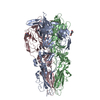
|
|---|---|
| 1 |
|
- 要素
要素
| #1: タンパク質 | 分子量: 51519.090 Da / 分子数: 3 / 由来タイプ: 組換発現 詳細: In chains A, B and C, residue Asn414 is covalently modified with an N-linked N-acetyl glucosamine ligand. Chains A, B and C each contain the following 15 disulfide bonds: Cys1-Cys41, Cys14- ...詳細: In chains A, B and C, residue Asn414 is covalently modified with an N-linked N-acetyl glucosamine ligand. Chains A, B and C each contain the following 15 disulfide bonds: Cys1-Cys41, Cys14-Cys23, Cys66-Cys162, Cys87-Cys135, Cys93-Cys142, Cys98-Cys123, Cys127-Cys132, Cys129-Cys138, Cys246-Cys257, Cys264-Cys277, Cys266-Cys275, Cys337-Cys408, Cys347-Cys350, Cys360-Cys382, Cys373-Cys404. 由来: (組換発現)  Ancylostoma ceylanicum (セイロン鉤虫) Ancylostoma ceylanicum (セイロン鉤虫)遺伝子: Acey_s0020.g108, Y032_0020g108 / プラスミド: pMT/BiP/V5-His / 細胞株 (発現宿主): d.mel-2 発現宿主:  参照: UniProt: A0A016UZK2 #2: 糖 | 研究の焦点であるリガンドがあるか | N | Has protein modification | Y | |
|---|
-実験情報
-実験
| 実験 | 手法: 電子顕微鏡法 |
|---|---|
| EM実験 | 試料の集合状態: PARTICLE / 3次元再構成法: 単粒子再構成法 |
- 試料調製
試料調製
| 構成要素 | 名称: Viral envelope glycoprotein / タイプ: COMPLEX 詳細: Envelope glycoprotein of endogenous retrovirus Y032 (Atlas virus) from Ancylostoma ceylanicum Entity ID: #1 / 由来: RECOMBINANT | |||||||||||||||||||||||||
|---|---|---|---|---|---|---|---|---|---|---|---|---|---|---|---|---|---|---|---|---|---|---|---|---|---|---|
| 分子量 | 値: 0.143 MDa / 実験値: YES | |||||||||||||||||||||||||
| 由来(天然) | 生物種:  Ancylostoma ceylanicum (セイロン鉤虫) Ancylostoma ceylanicum (セイロン鉤虫) | |||||||||||||||||||||||||
| 由来(組換発現) | 生物種:  細胞: d.mel-2 / プラスミド: pMT/BiP/V5-His | |||||||||||||||||||||||||
| 緩衝液 | pH: 8 詳細: 20 mM Tris/HCl (NH12C4O3Cl) 0.1 M NaCl 'sodium chloride' 5 % glycerol (C3H8O3) 0.5 mM TCEP (C9H15O6P) | |||||||||||||||||||||||||
| 緩衝液成分 |
| |||||||||||||||||||||||||
| 試料 | 濃度: 0.025 mg/ml / 包埋: NO / シャドウイング: NO / 染色: NO / 凍結: YES | |||||||||||||||||||||||||
| 試料支持 | グリッドの材料: COPPER / グリッドのサイズ: 400 divisions/in. / グリッドのタイプ: Quantifoil R1.2/1.3 | |||||||||||||||||||||||||
| 急速凍結 | 装置: FEI VITROBOT MARK IV / 凍結剤: ETHANE / 湿度: 100 % / 凍結前の試料温度: 277.2 K / 詳細: Grids were blotted for 4 s |
- 電子顕微鏡撮影
電子顕微鏡撮影
| 実験機器 |  モデル: Titan Krios / 画像提供: FEI Company |
|---|---|
| 顕微鏡 | モデル: FEI TITAN KRIOS |
| 電子銃 | 電子線源:  FIELD EMISSION GUN / 加速電圧: 300 kV / 照射モード: FLOOD BEAM FIELD EMISSION GUN / 加速電圧: 300 kV / 照射モード: FLOOD BEAM |
| 電子レンズ | モード: BRIGHT FIELD / 倍率(補正後): 75000 X / 最大 デフォーカス(公称値): 3500 nm / 最小 デフォーカス(公称値): 1300 nm / アライメント法: ZEMLIN TABLEAU |
| 試料ホルダ | 凍結剤: NITROGEN 試料ホルダーモデル: FEI TITAN KRIOS AUTOGRID HOLDER |
| 撮影 | 平均露光時間: 8 sec. / 電子線照射量: 46.18 e/Å2 / 検出モード: COUNTING フィルム・検出器のモデル: GATAN K2 SUMMIT (4k x 4k) 撮影したグリッド数: 1 / 実像数: 3027 / 詳細: Dose rate = 1.28 e- A^-2 per frame |
| 電子光学装置 | エネルギーフィルター名称: GIF Quantum LS / 色収差補正装置: None / エネルギーフィルタースリット幅: 20 eV / 位相板: OTHER / 球面収差補正装置: None |
| 画像スキャン | サンプリングサイズ: 5 µm / 横: 3838 / 縦: 3710 / 動画フレーム数/画像: 36 |
- 解析
解析
| ソフトウェア | 名称: PHENIX / バージョン: 1.17.1_3660: / 分類: 精密化 | ||||||||||||||||||||||||||||||||||||||||
|---|---|---|---|---|---|---|---|---|---|---|---|---|---|---|---|---|---|---|---|---|---|---|---|---|---|---|---|---|---|---|---|---|---|---|---|---|---|---|---|---|---|
| EMソフトウェア |
| ||||||||||||||||||||||||||||||||||||||||
| 画像処理 | 詳細: Movies were motion-corrected and dose-weighted with MOTIONCOR2. | ||||||||||||||||||||||||||||||||||||||||
| CTF補正 | 詳細: Aligned, non-dose-weighted micrographs were then used to estimate the CTF. タイプ: PHASE FLIPPING AND AMPLITUDE CORRECTION | ||||||||||||||||||||||||||||||||||||||||
| 粒子像の選択 | 選択した粒子像数: 987570 詳細: 2D references from initial datasets were used to auto-pick the micrographs. One round of reference-free 2D classification was performed to produce templates for better reference-dependent auto-picking. | ||||||||||||||||||||||||||||||||||||||||
| 対称性 | 点対称性: C3 (3回回転対称) | ||||||||||||||||||||||||||||||||||||||||
| 3次元再構成 | 解像度: 3.76 Å / 解像度の算出法: FSC 0.143 CUT-OFF / 粒子像の数: 197145 / アルゴリズム: FOURIER SPACE / クラス平均像の数: 1 / 対称性のタイプ: POINT | ||||||||||||||||||||||||||||||||||||||||
| 原子モデル構築 | B value: 82 / プロトコル: FLEXIBLE FIT / 空間: REAL / Target criteria: Cross-correlation coefficient 詳細: A homology model was built from PDB:6EGU using the Swiss-Model server (swissmodel.expasy.org). The model was docked as a rigid body into the density with UCSF Chimera prior to refinement. | ||||||||||||||||||||||||||||||||||||||||
| 原子モデル構築 | PDB-ID: 6EGU PDB chain-ID: A / Accession code: 6EGU 詳細: A homology model was built from PDB:6EGU using the Swiss-Model server (swissmodel.expasy.org). The model was docked as a rigid body into the density with UCSF Chimera prior to refinement. Pdb chain residue range: 691-1136 / Source name: PDB / タイプ: experimental model | ||||||||||||||||||||||||||||||||||||||||
| 拘束条件 |
|
 ムービー
ムービー コントローラー
コントローラー






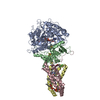
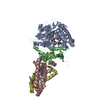
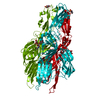

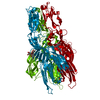
 PDBj
PDBj



